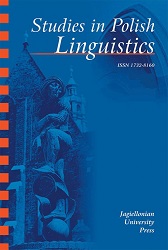Sonority Is Different
Sonority Is Different
Author(s): Tobias ScheerSubject(s): Phonetics / Phonology, Morphology, Lexis
Published by: Wydawnictwo Uniwersytetu Jagiellońskiego
Keywords: sonority; modularity; features; Elements; two phonologies; segment laryngeal properties; place of articulation;
Summary/Abstract: The paper argues that sonority on the one hand and other segmental properties such as place of articulation (labiality etc.) and laryngeal properties (voicing etc.) on the other hand are different in kind and must therefore not be represented alike: implementations on a par e.g. as features ([±voc], [±son], [±lab], [±voice] etc.) are misled. Arguments come from a number of broad, cross-linguistically stable facts concerning visibility of items below and above the skeleton in phonological and morphological processing: sonority, but no other segmental property, is taken into account when syllable structure is built (upward visibility); processes located above the skeleton (infixation, phonologically conditioned allomorphy, stress, tone, positional strength) do make reference to sonority, but never to labiality, voicing etc. (downward visibility). Approaches are discussed where sonority is encoded as structure, rather than as primes (features or Elements). In some cases not only sonority but also other segmental properties are structuralized, a solution that does not do justice to the insight that sonority and melody are different in kind. Also, the approaches that structuralize sonority are not concerned with the question how the representations they entertain come into being: representations are not contained in the phonetic signal that is the input to the linguistic system, nor do they fall from heaven – they are built by some computation. It is therefore concluded that what really segregates sonority and melody is their belonging to two distinct computational systems (modules in the Fodorian sense) which operate over distinct vocabularies and produce distinct structure: sonority primes are used to build syllable structure, while other computations take other types of primes as an input. The computation carrying out a palatalization for example works with melodic primes. The segment, then, is a lexical recording that has different compartments containing domain-specific primes [<sonority>, <melody>]segment. This is also the case of the morpheme, which hosts three compartments [<morpho-synt>, <sem>, <phon>]morpheme.
Journal: Studies in Polish Linguistics
- Issue Year: 2019
- Issue No: Special
- Page Range: 127-151
- Page Count: 25
- Language: English

